人教版(2019)必修第三册 Unit 1 Festivals and Celebrations Reading for Writing 课件(32张PPT含音频)
文档属性
| 名称 | 人教版(2019)必修第三册 Unit 1 Festivals and Celebrations Reading for Writing 课件(32张PPT含音频) |
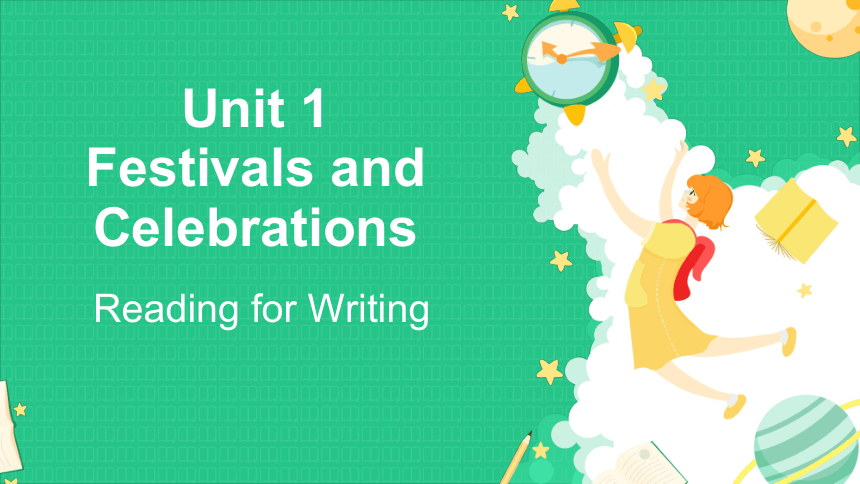
|
|
| 格式 | pptx | ||
| 文件大小 | 38.1MB | ||
| 资源类型 | 教案 | ||
| 版本资源 | 人教版(2019) | ||
| 科目 | 英语 | ||
| 更新时间 | 2023-05-15 15:44:37 | ||
图片预览

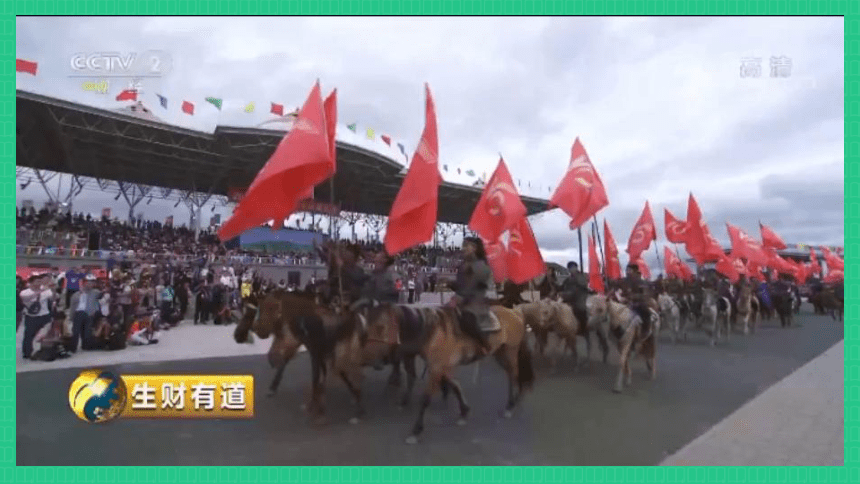
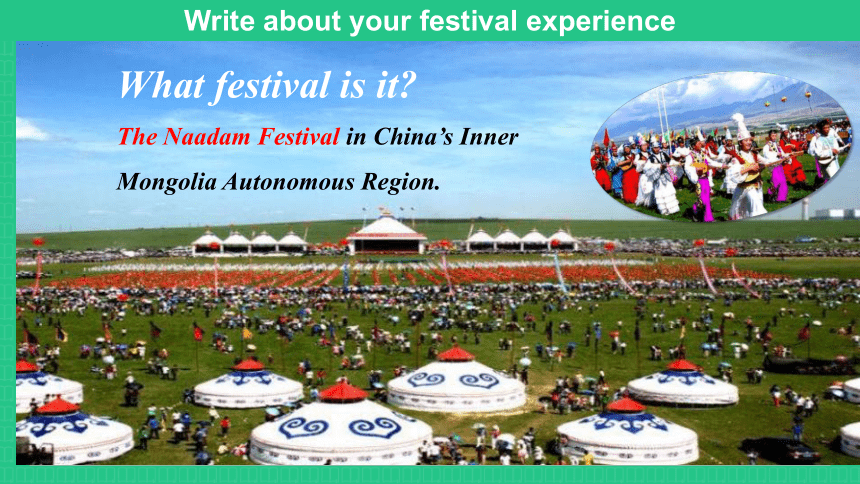
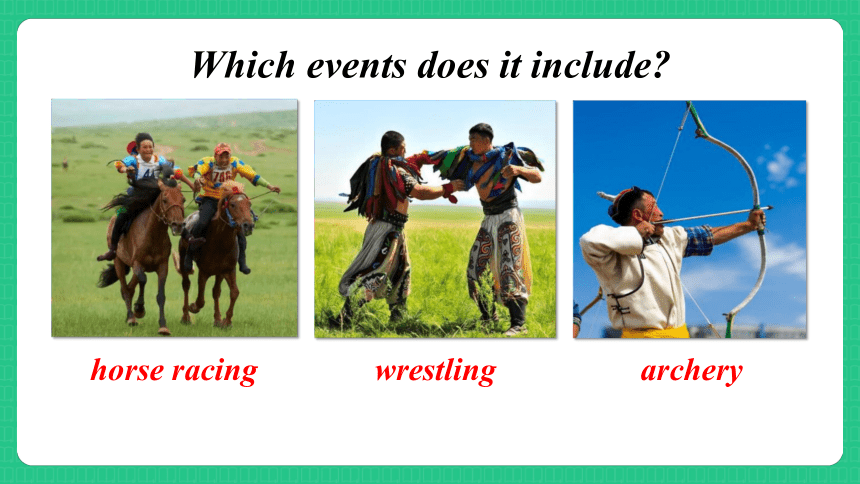
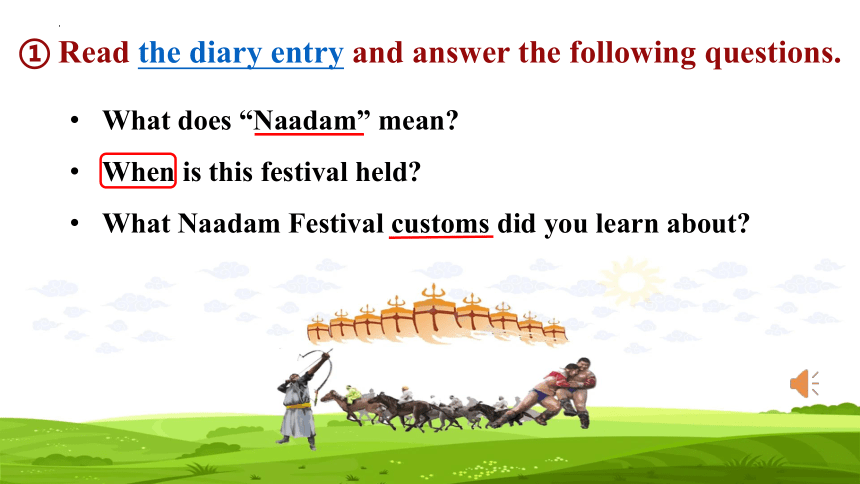
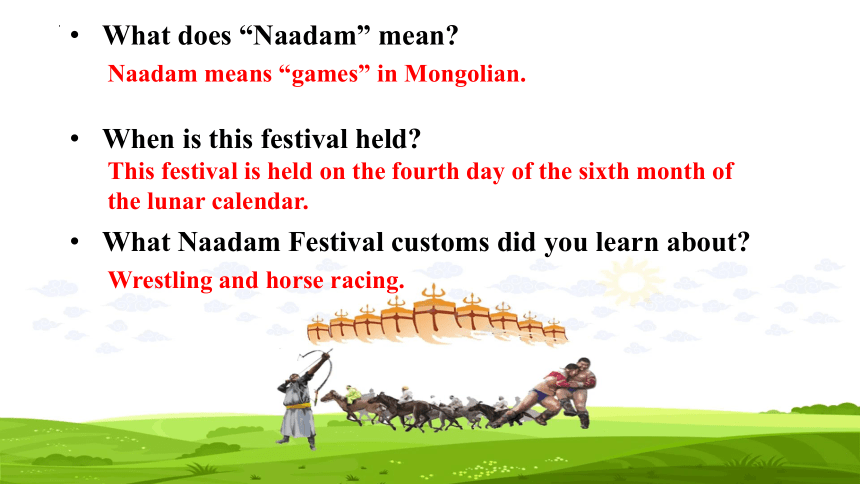
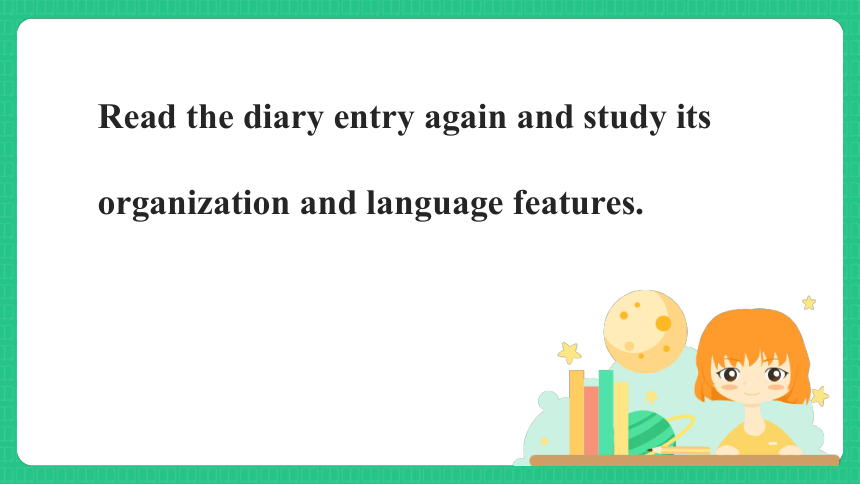
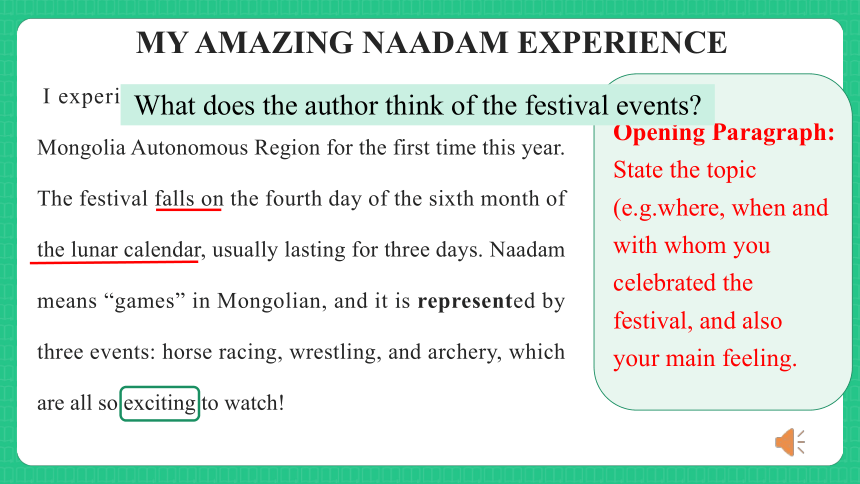
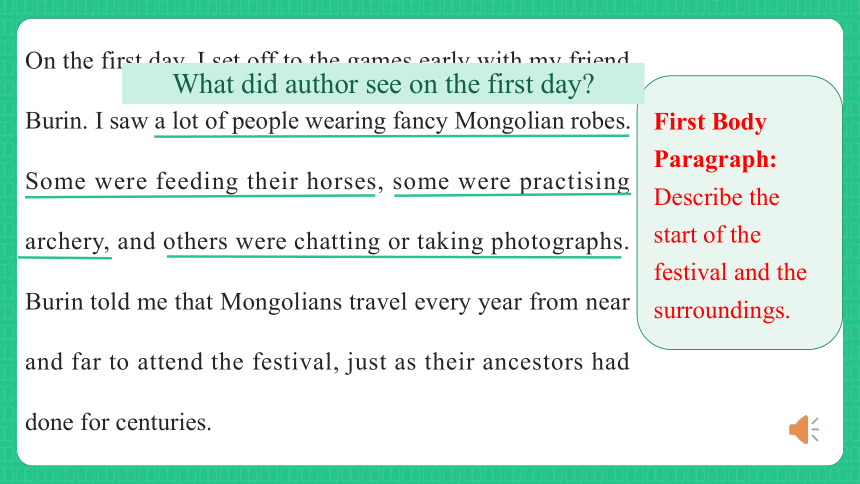
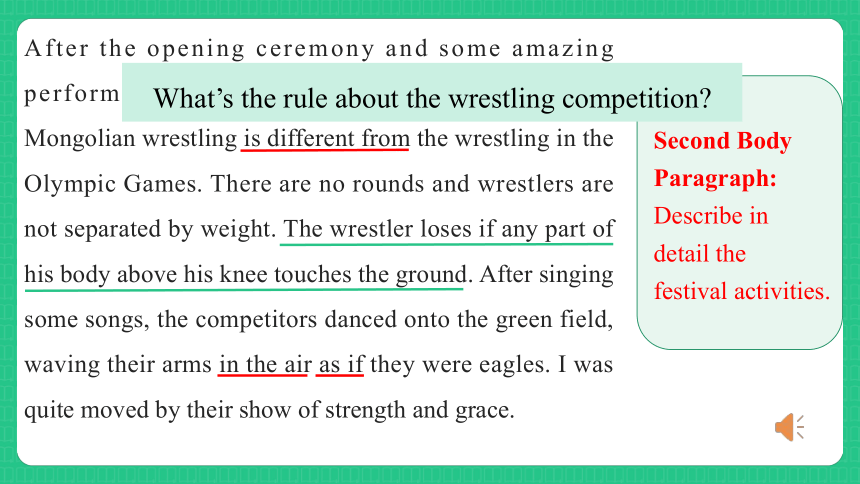
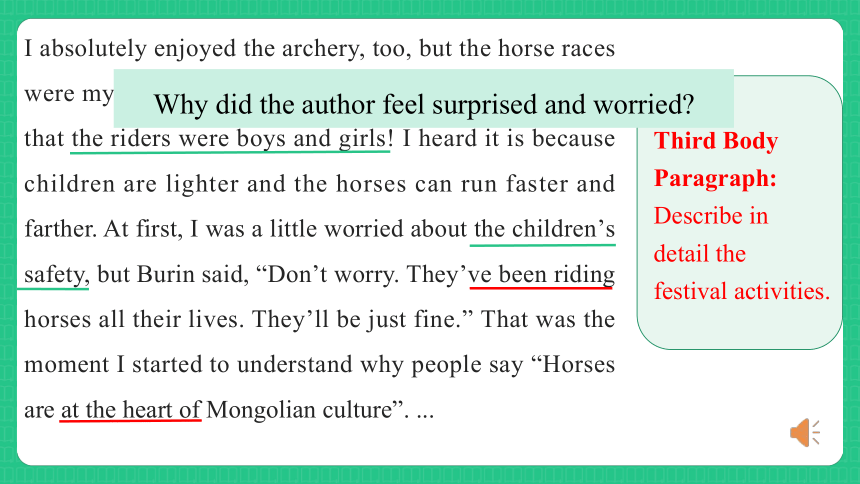
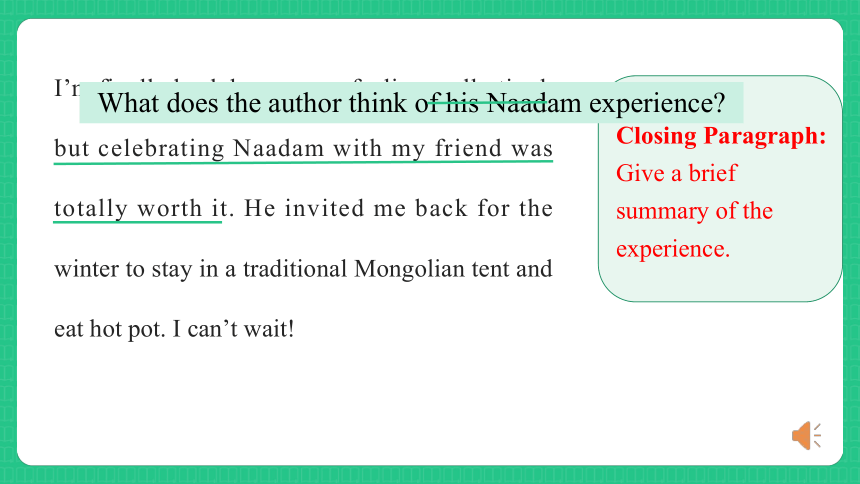
文档简介
(共32张PPT)
Unit 1 Festivals and Celebrations
Reading for Writing
Write about your festival experience
What festival is it
The Naadam Festival in China’s Inner Mongolia Autonomous Region.
Which events does it include
horse racing
wrestling
archery
What does “Naadam” mean
When is this festival held
What Naadam Festival customs did you learn about
① Read the diary entry and answer the following questions.
What does “Naadam” mean
When is this festival held
What Naadam Festival customs did you learn about
Naadam means “games” in Mongolian.
This festival is held on the fourth day of the sixth month of the lunar calendar.
Wrestling and horse racing.
Read the diary entry again and study its organization and language features.
MY AMAZING NAADAM EXPERIENCE
I experienced the Naadam Festival in China’s Inner Mongolia Autonomous Region for the first time this year. The festival falls on the fourth day of the sixth month of the lunar calendar, usually lasting for three days. Naadam means “games” in Mongolian, and it is represented by three events: horse racing, wrestling, and archery, which are all so exciting to watch!
Opening Paragraph:
State the topic (e.g.where, when and with whom you celebrated the festival, and also your main feeling.
What does the author think of the festival events
On the first day, I set off to the games early with my friend Burin. I saw a lot of people wearing fancy Mongolian robes. Some were feeding their horses, some were practising archery, and others were chatting or taking photographs. Burin told me that Mongolians travel every year from near and far to attend the festival, just as their ancestors had done for centuries.
First Body Paragraph:
Describe the start of the festival and the surroundings.
What did author see on the first day
After the opening ceremony and some amazing performances, the wrestling competition began. Mongolian wrestling is different from the wrestling in the Olympic Games. There are no rounds and wrestlers are not separated by weight. The wrestler loses if any part of his body above his knee touches the ground. After singing some songs, the competitors danced onto the green field, waving their arms in the air as if they were eagles. I was quite moved by their show of strength and grace.
Second Body Paragraph:
Describe in detail the festival activities.
What’s the rule about the wrestling competition
I absolutely enjoyed the archery, too, but the horse races were my favourite part. However, I was surprised to see that the riders were boys and girls! I heard it is because children are lighter and the horses can run faster and farther. At first, I was a little worried about the children’s safety, but Burin said, “Don’t worry. They’ve been riding horses all their lives. They’ll be just fine.” That was the moment I started to understand why people say “Horses are at the heart of Mongolian culture”. ...
Third Body Paragraph:
Describe in detail the festival activities.
Why did the author feel surprised and worried
I’m finally back home now, feeling really tired, but celebrating Naadam with my friend was totally worth it. He invited me back for the winter to stay in a traditional Mongolian tent and eat hot pot. I can’t wait!
Closing Paragraph:
Give a brief summary of the experience.
What does the author think of his Naadam experience
discussion
1. In your opinion, what is the most impressive thing about the festival
2. What else would you like to know about the festival and the writer’s experience
Suggested Answers:
1. The horse racing is the most impressive, as it involved little children.
Suggested Answers:
2. The writer did not talk about food or music, but surely they should have been interesting parts of the festival.
② Study the organisation and language features.
1 Read the sentence patterns below and use them to rewrite the opening sentence of the article.
This was my first time spending ... and it was an enjoyable and exciting experience for me.
I’ll never forget ... because ...
I’ll always ... because...
This was my first time spending my holiday in China’s Inner Mongolia Autonomous Region to celebrate the Naadam Festival, and it was an enjoyable and exciting experience for me.
I’ll never forget the Naadam Festival in China’s Inner Mongolia Autonomous Region because it was an enjoyable and exciting experience for me.
I’ll always remember the Naadam Festival in China’s Inner Mongolia Autonomous Region because it was an enjoyable and exciting experience for me.
2 Underline the sentences that describe the writer’s feelings and emotions.
...which are all so exciting to watch;
After the opening ceremony and some amazing performances;
I was quite moved by their show of strength and grace;
I absolutely enjoyed the archery, too, but the horse races were my favourite part;
I was surprised to see that the riders were boys and girls!
I was a little worried about the children’s safety;
feeling really tired;
... was totally worth it;
I can’t wait!
Use what you have learnt to write about a festival.
写作任务
某英文报社正在举行一次主题为“中国传统节日”的写作比赛,请你写一篇介绍中国传统节日的短文参赛。
注意:词数80左右
Make notes of your ideas.
Para 1: Brief introduction
Para 2: Details
Para 3: Conclusion
Name
Customs
Time
Place...
Importance...
Interaction with readers...
谋篇布局
the Mid-Autumn Festival
the lunar calendar
enjoy mooncakes
admire the moon
have a big dinner...
play a role in...
遣词造句
1. 中秋节在每年的农历八月十五。
Reference: (B3P8)
The festival falls on the fourth day of the sixth month of the lunar calendar.
The Mid-Autumn Festival falls on the fifteenth day of the eighth month of the lunar calendar.
2. 在中秋节时,要吃月饼。
During the Mid-Autumn Festival, people enjoy mooncakes.
3. 晚上,家人聚在一起吃大餐。
In the evening, families get together to have a big dinner.
4. 饭后,人们通常会和家人、朋友一起赏月。
After dinner, people usually admire the moon with their families and friends.
遣词造句
5. 中秋节是中国最古老的传统节日之一。
The Mid-Autumn Festival is one of the oldest traditional festivals in China.
It plays an important role in Chinese history and culture.
6. 它在中国的历史和文化中有着重要作用。
The Mid-Autumn Festival is my favorite festival. What about you What’s your favorite festival Feel free to share your ideas.
7. 中秋节是我最喜欢的节日。你呢?你最喜欢哪个节日?欢迎分享你的想法。
连句成篇
The Mid-Autumn Festival falls on the fifteenth day of the eighth month of the lunar calendar.
During the Mid-Autumn Festival, people enjoy mooncakes. In the evening, families get together to have a big dinner. After dinner, people usually admire the moon with their families and friends.
The Mid-Autumn Festival is one of the oldest traditional festivals in China. It plays an important role in Chinese history and culture.
The Mid-Autumn Festival falls on the fifteenth day of the eighth month of the lunar calendar.
First of all, during the Mid-Autumn Festival people enjoy mooncakes. Besides, in the evening families get together to have a big dinner. What’s more important, after dinner people usually admire the moon with their families and friends.
The Mid-Autumn Festival is one of the oldest traditional festivals in China. It plays an important role in Chinese history and culture.
Here are some customs about how to celebrate the festival.
升级修改1
There are a wide range of customs for people to celebrate the festival.
Chinese people have been celebrating the festival for centuries.
gather
most ancient
a significant
delicious
shining
升级修改1
The Mid-Autumn Festival falls on the fifteenth day of the eighth month of the lunar calendar. Chinese people have been celebrating the festival for centuries.
First of all, during the Mid-Autumn Festival people enjoy delicious mooncakes. Besides, in the evening families gather together to have a big dinner. What’s more important, after dinner people usually admire the shining moon with their families and friends.
The Mid-Autumn Festival is one of the most ancient traditional festivals in China. It plays a significant role in Chinese history and culture.
修改升级2
The Mid-Autumn Festival falls on the fifteenth day of the eighth month of the lunar calendar. Chinese people have been celebrating the festival for centuries.
The Mid-Autumn Festival falls on the fifteenth day of the eighth month of the lunar calendar, which Chinese people have been celebrating for centuries.
Chinese people have been celebrating the Mid-Autumn Festival for centuries, which falls on the fifteenth day of the eighth month of the lunar calendar.
Reference: (B2P20)
When it comes to wildlife protection, all species — the good, the bad, and the ugly — should be treated equally.
Falling on the fifteenth day of the eighth month of the lunar calendar, the Mid-Autumn Festival has been celebrated by Chinese people for centuries.
Having been celebrated by Chinese people for centuries, the Mid-Autumn Festival falls on the fifteenth day of the eighth month of the lunar calendar.
When it comes to Chinese traditional festivals, the Mid-Autumn Festival is expected to be mentioned. This festival falls on the fifteenth day of the eighth month of the lunar calendar.
When it comes to Chinese traditional festivals, the Mid-Autumn Festival is expected to be mentioned. Chinese people have been celebrating the festival for centuries.
The festival has been celebrated by Chinese people for
修改升级2
During the Mid-Autumn Festival, people enjoy delicious mooncakes.
During the Mid-Autumn Festival, people enjoy delicious mooncakes unique to this festival.
During the Mid-Autumn Festival, people enjoy delicious mooncakes, which are in the shape of the full moon on the Mid-Autumn night.
Reference: (B1P26)
It is for this reason that Spanish is the main official language of Peru.
It is for this reason that they are called “moon” cakes.
Reference: (B1P26)
...enjoying the plants and animals unique to the rainforest.
修改升级2
In the evening, families gather together to have a big dinner.
In the evening, families gather together to celebrate the festival with a big meal.
In the evening, families gather together to have a big dinner. No matter how far they are from their homes, they will spare no effort to come back for the reunion.
修改升级2
After dinner, people usually admire the shining moon with their families and friends.
After dinner, people usually admire the shining moon with their families and friends. They can look back on the past and look forward to the future.
After dinner, people usually admire the shining moon with their families and friends. The roundness of the full moon on the Mid-Autumn night is regarded as a symbol of reunion and happiness by Chinese people.
修改升级2
The Mid-Autumn Festival is one of the most ancient traditional festivals in China, which plays a significant role in Chinese history and culture.
The Mid-Autumn Festival is one of the most ancient traditional festivals in China. It plays a significant role in Chinese history and culture.
The Mid-Autumn Festival is one of the most ancient traditional festivals in China, playing a significant role in Chinese history and culture.
As one of the most ancient traditional festivals in China, the Mid-Autumn Festival plays a significant role in Chinese history and culture.
When it comes to Chinese traditional festival, the Mid-Autumn Festival is expected to be mentioned. This festival falls on the fifteenth day of the eighth month of the lunar calendar.
During the Mid-Autumn, Festival people enjoy delicious mooncakes, which are in the shape of the full moon on the Mid-Autumn night. It is for this reason that they are called “moon” cakes. In the evening, families gather together to celebrate the festival with a big meal. After dinner, people usually admire the shining moon with their families and friends.
The Mid-Autumn Festival is one of the most ancient traditional festivals in China, playing a significant role in Chinese history and culture.
Falling on the fifteenth day of the eighth month of the lunar calendar, the Mid-Autumn Festival has been celebrated by Chinese people for centuries.
During the Mid-Autumn Festival, people enjoy delicious mooncakes unique to this festival. In the evening, families gather together to celebrate the festival with a big meal. After dinner, people usually admire the shining moon with their families and friends. The roundness of the full moon on the Mid-Autumn night is regarded as a symbol of reunion and happiness by Chinese people.
As one of the most ancient traditional festivals in China, the Mid-Autumn Festival plays a significant role in Chinese history and culture.
Homework(小本P124)
假定你是李华,你的美国网友Tim对中国的春节很好奇,写信向你询问一些春节的习俗。请你给他写一封回信,内容包括:
1. 春节的时间;
2. 中国人庆祝春节的方式;
3. 欢迎他来中国过春节。
注意:1. 词数80左右;
2. 可以适当增加细节,以使行文连贯。
Thank You for Listening!
Unit 1 Festivals and Celebrations
Reading for Writing
Write about your festival experience
What festival is it
The Naadam Festival in China’s Inner Mongolia Autonomous Region.
Which events does it include
horse racing
wrestling
archery
What does “Naadam” mean
When is this festival held
What Naadam Festival customs did you learn about
① Read the diary entry and answer the following questions.
What does “Naadam” mean
When is this festival held
What Naadam Festival customs did you learn about
Naadam means “games” in Mongolian.
This festival is held on the fourth day of the sixth month of the lunar calendar.
Wrestling and horse racing.
Read the diary entry again and study its organization and language features.
MY AMAZING NAADAM EXPERIENCE
I experienced the Naadam Festival in China’s Inner Mongolia Autonomous Region for the first time this year. The festival falls on the fourth day of the sixth month of the lunar calendar, usually lasting for three days. Naadam means “games” in Mongolian, and it is represented by three events: horse racing, wrestling, and archery, which are all so exciting to watch!
Opening Paragraph:
State the topic (e.g.where, when and with whom you celebrated the festival, and also your main feeling.
What does the author think of the festival events
On the first day, I set off to the games early with my friend Burin. I saw a lot of people wearing fancy Mongolian robes. Some were feeding their horses, some were practising archery, and others were chatting or taking photographs. Burin told me that Mongolians travel every year from near and far to attend the festival, just as their ancestors had done for centuries.
First Body Paragraph:
Describe the start of the festival and the surroundings.
What did author see on the first day
After the opening ceremony and some amazing performances, the wrestling competition began. Mongolian wrestling is different from the wrestling in the Olympic Games. There are no rounds and wrestlers are not separated by weight. The wrestler loses if any part of his body above his knee touches the ground. After singing some songs, the competitors danced onto the green field, waving their arms in the air as if they were eagles. I was quite moved by their show of strength and grace.
Second Body Paragraph:
Describe in detail the festival activities.
What’s the rule about the wrestling competition
I absolutely enjoyed the archery, too, but the horse races were my favourite part. However, I was surprised to see that the riders were boys and girls! I heard it is because children are lighter and the horses can run faster and farther. At first, I was a little worried about the children’s safety, but Burin said, “Don’t worry. They’ve been riding horses all their lives. They’ll be just fine.” That was the moment I started to understand why people say “Horses are at the heart of Mongolian culture”. ...
Third Body Paragraph:
Describe in detail the festival activities.
Why did the author feel surprised and worried
I’m finally back home now, feeling really tired, but celebrating Naadam with my friend was totally worth it. He invited me back for the winter to stay in a traditional Mongolian tent and eat hot pot. I can’t wait!
Closing Paragraph:
Give a brief summary of the experience.
What does the author think of his Naadam experience
discussion
1. In your opinion, what is the most impressive thing about the festival
2. What else would you like to know about the festival and the writer’s experience
Suggested Answers:
1. The horse racing is the most impressive, as it involved little children.
Suggested Answers:
2. The writer did not talk about food or music, but surely they should have been interesting parts of the festival.
② Study the organisation and language features.
1 Read the sentence patterns below and use them to rewrite the opening sentence of the article.
This was my first time spending ... and it was an enjoyable and exciting experience for me.
I’ll never forget ... because ...
I’ll always ... because...
This was my first time spending my holiday in China’s Inner Mongolia Autonomous Region to celebrate the Naadam Festival, and it was an enjoyable and exciting experience for me.
I’ll never forget the Naadam Festival in China’s Inner Mongolia Autonomous Region because it was an enjoyable and exciting experience for me.
I’ll always remember the Naadam Festival in China’s Inner Mongolia Autonomous Region because it was an enjoyable and exciting experience for me.
2 Underline the sentences that describe the writer’s feelings and emotions.
...which are all so exciting to watch;
After the opening ceremony and some amazing performances;
I was quite moved by their show of strength and grace;
I absolutely enjoyed the archery, too, but the horse races were my favourite part;
I was surprised to see that the riders were boys and girls!
I was a little worried about the children’s safety;
feeling really tired;
... was totally worth it;
I can’t wait!
Use what you have learnt to write about a festival.
写作任务
某英文报社正在举行一次主题为“中国传统节日”的写作比赛,请你写一篇介绍中国传统节日的短文参赛。
注意:词数80左右
Make notes of your ideas.
Para 1: Brief introduction
Para 2: Details
Para 3: Conclusion
Name
Customs
Time
Place...
Importance...
Interaction with readers...
谋篇布局
the Mid-Autumn Festival
the lunar calendar
enjoy mooncakes
admire the moon
have a big dinner...
play a role in...
遣词造句
1. 中秋节在每年的农历八月十五。
Reference: (B3P8)
The festival falls on the fourth day of the sixth month of the lunar calendar.
The Mid-Autumn Festival falls on the fifteenth day of the eighth month of the lunar calendar.
2. 在中秋节时,要吃月饼。
During the Mid-Autumn Festival, people enjoy mooncakes.
3. 晚上,家人聚在一起吃大餐。
In the evening, families get together to have a big dinner.
4. 饭后,人们通常会和家人、朋友一起赏月。
After dinner, people usually admire the moon with their families and friends.
遣词造句
5. 中秋节是中国最古老的传统节日之一。
The Mid-Autumn Festival is one of the oldest traditional festivals in China.
It plays an important role in Chinese history and culture.
6. 它在中国的历史和文化中有着重要作用。
The Mid-Autumn Festival is my favorite festival. What about you What’s your favorite festival Feel free to share your ideas.
7. 中秋节是我最喜欢的节日。你呢?你最喜欢哪个节日?欢迎分享你的想法。
连句成篇
The Mid-Autumn Festival falls on the fifteenth day of the eighth month of the lunar calendar.
During the Mid-Autumn Festival, people enjoy mooncakes. In the evening, families get together to have a big dinner. After dinner, people usually admire the moon with their families and friends.
The Mid-Autumn Festival is one of the oldest traditional festivals in China. It plays an important role in Chinese history and culture.
The Mid-Autumn Festival falls on the fifteenth day of the eighth month of the lunar calendar.
First of all, during the Mid-Autumn Festival people enjoy mooncakes. Besides, in the evening families get together to have a big dinner. What’s more important, after dinner people usually admire the moon with their families and friends.
The Mid-Autumn Festival is one of the oldest traditional festivals in China. It plays an important role in Chinese history and culture.
Here are some customs about how to celebrate the festival.
升级修改1
There are a wide range of customs for people to celebrate the festival.
Chinese people have been celebrating the festival for centuries.
gather
most ancient
a significant
delicious
shining
升级修改1
The Mid-Autumn Festival falls on the fifteenth day of the eighth month of the lunar calendar. Chinese people have been celebrating the festival for centuries.
First of all, during the Mid-Autumn Festival people enjoy delicious mooncakes. Besides, in the evening families gather together to have a big dinner. What’s more important, after dinner people usually admire the shining moon with their families and friends.
The Mid-Autumn Festival is one of the most ancient traditional festivals in China. It plays a significant role in Chinese history and culture.
修改升级2
The Mid-Autumn Festival falls on the fifteenth day of the eighth month of the lunar calendar. Chinese people have been celebrating the festival for centuries.
The Mid-Autumn Festival falls on the fifteenth day of the eighth month of the lunar calendar, which Chinese people have been celebrating for centuries.
Chinese people have been celebrating the Mid-Autumn Festival for centuries, which falls on the fifteenth day of the eighth month of the lunar calendar.
Reference: (B2P20)
When it comes to wildlife protection, all species — the good, the bad, and the ugly — should be treated equally.
Falling on the fifteenth day of the eighth month of the lunar calendar, the Mid-Autumn Festival has been celebrated by Chinese people for centuries.
Having been celebrated by Chinese people for centuries, the Mid-Autumn Festival falls on the fifteenth day of the eighth month of the lunar calendar.
When it comes to Chinese traditional festivals, the Mid-Autumn Festival is expected to be mentioned. This festival falls on the fifteenth day of the eighth month of the lunar calendar.
When it comes to Chinese traditional festivals, the Mid-Autumn Festival is expected to be mentioned. Chinese people have been celebrating the festival for centuries.
The festival has been celebrated by Chinese people for
修改升级2
During the Mid-Autumn Festival, people enjoy delicious mooncakes.
During the Mid-Autumn Festival, people enjoy delicious mooncakes unique to this festival.
During the Mid-Autumn Festival, people enjoy delicious mooncakes, which are in the shape of the full moon on the Mid-Autumn night.
Reference: (B1P26)
It is for this reason that Spanish is the main official language of Peru.
It is for this reason that they are called “moon” cakes.
Reference: (B1P26)
...enjoying the plants and animals unique to the rainforest.
修改升级2
In the evening, families gather together to have a big dinner.
In the evening, families gather together to celebrate the festival with a big meal.
In the evening, families gather together to have a big dinner. No matter how far they are from their homes, they will spare no effort to come back for the reunion.
修改升级2
After dinner, people usually admire the shining moon with their families and friends.
After dinner, people usually admire the shining moon with their families and friends. They can look back on the past and look forward to the future.
After dinner, people usually admire the shining moon with their families and friends. The roundness of the full moon on the Mid-Autumn night is regarded as a symbol of reunion and happiness by Chinese people.
修改升级2
The Mid-Autumn Festival is one of the most ancient traditional festivals in China, which plays a significant role in Chinese history and culture.
The Mid-Autumn Festival is one of the most ancient traditional festivals in China. It plays a significant role in Chinese history and culture.
The Mid-Autumn Festival is one of the most ancient traditional festivals in China, playing a significant role in Chinese history and culture.
As one of the most ancient traditional festivals in China, the Mid-Autumn Festival plays a significant role in Chinese history and culture.
When it comes to Chinese traditional festival, the Mid-Autumn Festival is expected to be mentioned. This festival falls on the fifteenth day of the eighth month of the lunar calendar.
During the Mid-Autumn, Festival people enjoy delicious mooncakes, which are in the shape of the full moon on the Mid-Autumn night. It is for this reason that they are called “moon” cakes. In the evening, families gather together to celebrate the festival with a big meal. After dinner, people usually admire the shining moon with their families and friends.
The Mid-Autumn Festival is one of the most ancient traditional festivals in China, playing a significant role in Chinese history and culture.
Falling on the fifteenth day of the eighth month of the lunar calendar, the Mid-Autumn Festival has been celebrated by Chinese people for centuries.
During the Mid-Autumn Festival, people enjoy delicious mooncakes unique to this festival. In the evening, families gather together to celebrate the festival with a big meal. After dinner, people usually admire the shining moon with their families and friends. The roundness of the full moon on the Mid-Autumn night is regarded as a symbol of reunion and happiness by Chinese people.
As one of the most ancient traditional festivals in China, the Mid-Autumn Festival plays a significant role in Chinese history and culture.
Homework(小本P124)
假定你是李华,你的美国网友Tim对中国的春节很好奇,写信向你询问一些春节的习俗。请你给他写一封回信,内容包括:
1. 春节的时间;
2. 中国人庆祝春节的方式;
3. 欢迎他来中国过春节。
注意:1. 词数80左右;
2. 可以适当增加细节,以使行文连贯。
Thank You for Listening!
